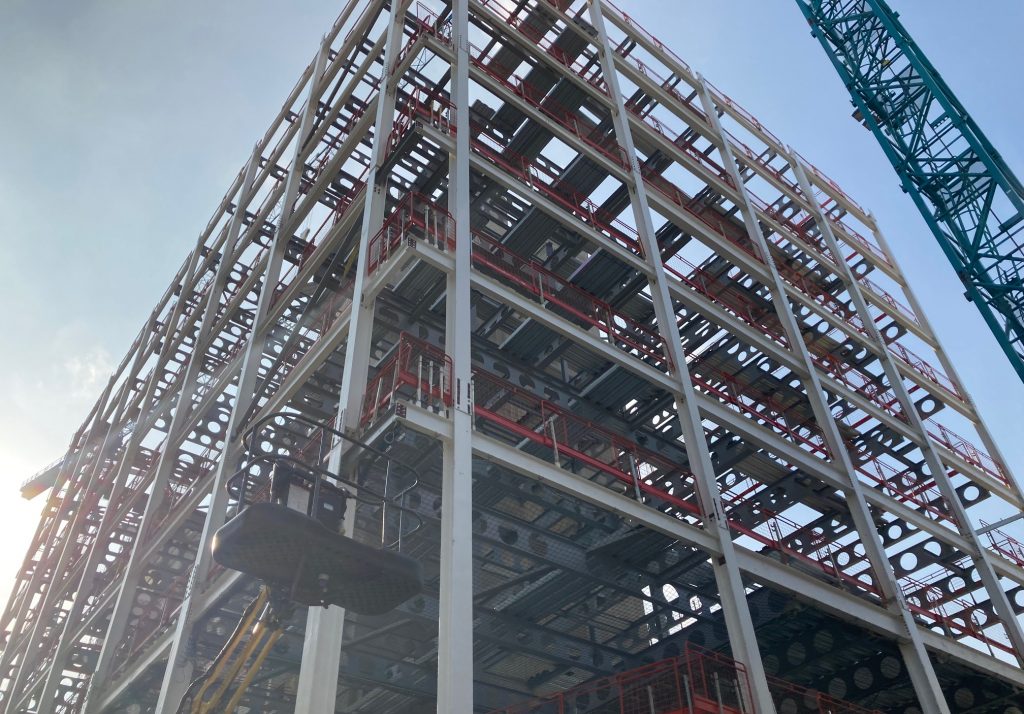To create a truly sustainable construction sector, working with the building stock we already have is key.
Retrofitting or reconfiguring existing buildings – including adapting their structural frames – will be essential for the construction and built environment sectors to meet demand for modern, flexible spaces for working, living, leisure and travel. This will not only support recovery from the pandemic but also work towards global net zero targets.
Known as ‘adaptive reuse’ adapting a frame updates a building’s key features while retaining the integrity and aesthetic of the original structure. It could be to change the appearance of a building or to modify or update functionality, such as improving weather or heat resistance. It could also be to entirely overhaul a property’s usage, from commercial to residential, for example.
Examples of adapting frames or buildings include: change of use; extensions or linking new spaces; partial demolition; creating or closing openings; or, retrofitting, refurbishing or renovating existing features.
Whatever the reason for adapting a frame, whether it’s a steel frame or reinforced concrete, there are four key considerations for main clients and contractors to bear in mind:
- Accountability & Responsibility
These considerations are two-fold, covering the regulatory requirements for construction works, such as securing planning permission, and the safe and correct disposal or replacement of components.
What works are permitted and whether further planning permission will be required should be determined at the very outset of a project. This will dictate what works can take place and also how, where and when. Projects requiring extensive work are likely to be subject to Construction (Design & Management) Regulations, ensuring responsible and compliant completion.
Where parts of a frame or building, such as members, windows or walls, need to be permanently removed efficient and responsible management and disposal of materials is key. For example, if components with fire protection are removed, what alternative or replacement fire prevention measures will need to go in and when?
- Accessibility & Location
How and where a frame’s floors are accessible will dictate not just what is possible, but programme timings. For example, do you need to go in from above or can voids be created, from which to access or construct features? The accessibility of floor spaces will also impact decisions around options or requirements for updated services, additional insulation or new mechanical or electrical systems.
As well as frame accessibility, building accessibility and location are key. While a property’s proximity to other amenities, such as transport links, office blocks or residential areas, might make it attractive for adaptive reuse, these may also impact what is possible logistically. Buildings located in busy city centre locations mean site access can dictate what work can be carried out. This can include whether a property is a listed building or stands in a conservation area, or whether it stands within, or above, key transport links whose timetables cannot be disturbed by construction works and deliveries.
- Craneage
Once the location and parameters it sets are understood, the types, size and number of plant required to undertake work must be considered. Retaining elements of an existing structure can create challenges for the siting, size and use of cranes to lift and position new materials, increasing the likelihood of manual handling or smaller members being required. A clear understanding of the strength and shape of the existing frame and careful logistics planning, including routes to bring materials in or onto a frame, are essential. Where a frame is being part-dismantled, temporary loss of strength or stability will impact its loading capacity.
- Surveying & Documenting
To ensure adaptive works are completed comprehensively, efficiently and safely, a complete assessment of the building is required, surveying and documenting its existing condition. This will identify components to be kept, replaced or updated, or removed entirely; understanding the useable life of components, anticipated lifetime value and maintenance history. As with the craneage considerations, this will inform on what loads the existing frame can take during works, alongside the future operational, services and mechanical requirements.
Accurately updating information on connections, components and key parts of both the old frame and updated elements to share with the building’s owners and/or managers and end-users will be essential for safety.
Buildings which have the structural integrity and adaptability to be reconfigured will help the built environment and construction sector to sustainably meet demand – creating new spaces with minimal waste creation nor reliance on raw materials.
The success of adaptive works will rely not only on working to the key considerations listed, but also the skill and expertise of those involved. Understanding the requirements, parameters and processes of retrofitting and adapting frames is a vital part of modern, sustainable construction. Working with experienced, creative suppliers and contractors will support this.

